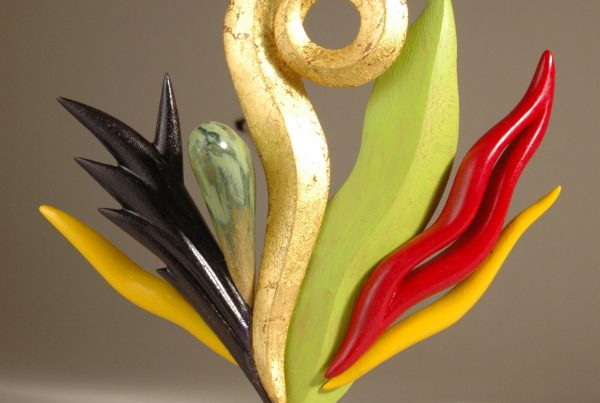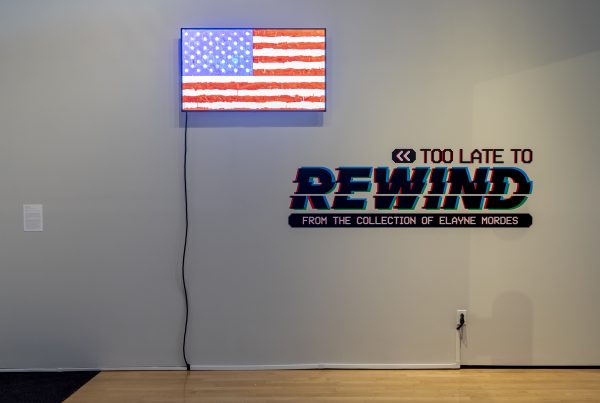What better place to start a review of “Belief + Doubt,” the NSU Art Museum’s illuminating exhibition drawn from the collection of longtime Broward art patrons Francie Bishop Good and David Horvitz, than with arguably its most celebrated artist?

The lone photograph by Cindy Sherman, #19 in her “Film Stills” series, features the chameleonic performance artist adopting the persona of a traditional movie heroine, in an image convincingly staged to resemble an image from a classic film. For this shot, the pioneering feminist is clad as a suburban homemaker with a quaint bonnet, overdressed in front of a red brick building. She’s the very picture of a fraying, wandering housewife from a Douglas Sirk melodrama.
The image, like the rest of her canon, plays tricks with the eye to make a point: in this case, to subvert and expose clichés of the country’s most popular entertainment medium. And it’s far from this exhibition’s only case of a contemporary artist toying with our perception.
“Belief + Doubt” is the bounty of Good and Horvitz’s promised donation of more than 100 artworks to the NSU Art Museum, about 70 of which comprise this exhibition. It’s natural and inevitable for the viewer to scour the individual pieces for themes—the connective tissue linking one piece to the next that, in totality, forms a collector’s taste. For Good and Horvitz, this was not a strenuous challenge: Deception is at the heart of so many of these works that it could qualify as a conscious or unconscious obsession, if not a mandate.
The exhibition opens with a gallery of images from the so-called “Pictures Generation,” the Gen-X artists whose appropriated imagery questioned the consumer culture in which they were raised. Sherman’s “Film Stills” were a part of this movement, and we also get some enticing tapas from Laurie Simmons (“Untitled Dummy/Beach 1,” with the titular doll smiling vacantly at the camera lens) and Barbara Kruger (“Belief + Doubt = Sanity”, an iconic work of concise poetry and ambiguously charged imagery). The most impactful, for me, is Louise Lawler’s “Big,” with its deadpan wit and inside-art-world juxtapositions, which “beheads” a famous sculpture and presents an exhibition-in-transition is something akin to a crime scene.

Other sections in the exhibit are divided into categories like “The Sleep of Reason,” “Seeing is Believing” and “Suspension of Disbelief,” but all of them feel like valves feeding the same thematic heart: art’s ability to obfuscate the truth, not reveal it. The artists prized by these collectors return to deception again and again, such as Frances Trombly’s double-take-inducing “Receipts,” which initially presents as a collection of crinkly supermarket receipts scattered on the museum floor. On closer inspection, the receipts are indeed individual objects of art, meticulously sewn to imitate the disposable originals, offering a potent commentary about such “women’s work” as shopping and needlecraft.

Gillian Wearing’s “Trauma #1” most literalizes the illusory nature of art by staging a portrait of a woman covered in a mask that conceals her real emotions, letting us decipher the truth as best we can through the mask’s eyeholes: Interpretation is in the eye of the beholder and the beheld. Teresita Fernandez’s “Dew” is an elegant optical illusion, a series of crystalline acrylic cubes in various shades of blue that, when organized just so, simulate the falling of morning dew. Mona Hatoum’s “Infinity” is a small-scale sculpture of the infinity sign whose symbolic meaning changes when you observe the material: bronze soldiers, bearing guns, linked together in semiotic harmony. They suggest that war, like the image they’re forming, is forever.

Sue Williams’ “Pink and Blue” is also subversive in its trickery. At first glance, it’s a benign series of painted abstract doodles. Upon inspection, the lines take on erotically charged shapes—a deliberate attempt to radically feminize the machismo-laden history of abstract expressionism. Ann Hamilton’s video “Untitled (Honey/Pocket)” approaches sexual subversion in a similar way, turning a strange but G-rated practice—using one’s hand to squish and pummel honey inside the pockets of trousers worn by the artist—into something that looks and sounds like an erotic act, and continues for an uncomfortable 30 minutes.
These works fall under one of the show’s sub-themes as well: the female body, its reproductive system and its objectification, most hauntingly evoked by Cecily Brown’s sexual-assault nightmare “Puce Moment” and most amusingly approached by E.V. Day’s “Mummified Barbies,” which are sculptures of exactly what they sound like. There also are extraordinary meditations on race, such as Kara Walker’s shadowy, picture book-style collages of slave life, or Carrie Mae Weems’ toned silver prints, which rebuke the tradition of labeling people by color.

But even these works have some element of theatrical surprise to them, a formal ingenuity that both nurtures and ultimately supersedes the historical criticism and the revisionist questioning of social norms. Truth is illusory; the world is a stage. Even when you think you’ve grasped a piece, it slips out of its paradigm to form something else, encouraging us to question everything. Yet emotionally, these artists cut to the heart of the human experience, opening our eyes to new possibilities. We believe them even when we doubt them.
“Belief + Doubt” runs through Jan. 22 at NSU Art Museum, 1 E. Las Olas Blvd., Fort Lauderdale. Admission costs $5-$12. Call 954/525-5500 or visit nsuartmuseum.org.







